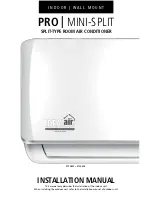
4 Installation
Installation manual
7
RXA20~35A2V1B
R32 split series
3P517827-1 – 2017.12
Item
Tightening torque (N∙m)
Stem cap, liquid side
21.6~28.4
Stem cap, gas side
21.6~28.4
Item
Tightening torque (N∙m)
Service port cap
10.8~14.7
4.2.3
To connect the refrigerant piping to the
outdoor unit
▪
Piping length.
Keep field piping as short as possible.
▪
Piping protection.
Protect the field piping against physical
damage.
WARNING
Connect the refrigerant piping securely before running the
compressor. If the refrigerant piping is NOT connected and
the stop valve is open when the compressor is run, air will
be sucked in. This will cause abnormal pressure in the
refrigeration cycle, which may result in equipment damage
and even injury.
CAUTION
▪ Use the flare nut fixed to the unit.
▪ To prevent gas leakage, apply refrigeration oil only to
the inside of the flare. Use refrigeration oil for R32.
▪ Do NOT reuse joints.
1
Connect the liquid refrigerant connection from the indoor unit to
the liquid stop valve of the outdoor unit.
a
b
c
a
Liquid stop valve
b
Gas stop valve
c
Service port
2
Connect the gas refrigerant connection from the indoor unit to
the gas stop valve of the outdoor unit.
NOTICE
It is recommended that the refrigerant piping between
indoor and outdoor unit is installed in a ducting or the
refrigerant piping is wrapped with finishing tape.
4.3
Checking the refrigerant piping
4.3.1
To check for leaks
NOTICE
Do NOT exceed the unit's maximum working pressure (see
"PS High" on the unit name plate).
NOTICE
Make sure to use a recommended bubble test solution
from your wholesaler. Do not use soap water, which may
cause cracking of flare nuts (soap water may contain salt,
which absorbs moisture that will freeze when the piping
gets cold), and/or lead to corrosion of flared joints (soap
water may contain ammonia which causes a corrosive
effect between the brass flare nut and the copper flare).
1
Charge the system with nitrogen gas up to a gauge pressure of
at least 200 kPa (2 bar). It is recommended to pressurize to
3000 kPa (30 bar) in order to detect small leaks.
2
Check for leaks by applying the bubble test solution to all
connections.
3
Discharge all nitrogen gas.
4.3.2
To perform vacuum drying
DANGER: RISK OF EXPLOSION
Do NOT start the unit if it is vacuumed.
1
Vacuum the system until the pressure on the manifold indicates
−0.1 MPa (−1 bar).
2
Leave as is for 4-5 minutes and check the pressure:
If the pressure…
Then…
Does not change
There is no moisture in the
system. This procedure is
finished.
Increases
There is moisture in the
system. Go to the next step.
3
Vacuum the system for at least 2 hours to a manifold pressure
of −0.1 MPa (−1 bar).
4
After turning the pump OFF, check the pressure for at least
1 hour.
5
If you do NOT reach the target vacuum or CANNOT maintain
the vacuum for 1 hour, do the following:
▪ Check for leaks again.
▪ Perform vacuum drying again.
NOTICE
Make sure to open the stop valves after installing the
refrigerant piping and performing vacuum drying. Running
the system with the stop valves closed may break the
compressor.
4.4
Charging refrigerant
4.4.1
About charging refrigerant
The outdoor unit is factory charged with refrigerant, but in some
cases the following might be necessary:
What
When
Charging additional refrigerant
When the total liquid piping
length is more than specified
(see later).
Completely recharging refrigerant
Example:
▪ When relocating the system.
▪ After a leak.
Charging additional refrigerant
Before charging additional refrigerant, make sure the outdoor unit's
external
refrigerant piping is checked (leak test, vacuum drying).
INFORMATION
Depending on the units and/or the installation conditions, it
might be necessary to connect electrical wiring before you
can charge refrigerant.
Typical workflow – Charging additional refrigerant typically consists
of the following stages:
1 Determining if and how much you have to charge additionally.
2 If necessary, charging additional refrigerant.
3 Filling in the fluorinated greenhouse gases label, and fixing it to
the inside of the outdoor unit.


































